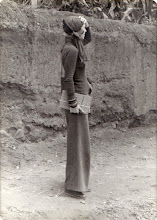dimanche 29 novembre 2009
samedi 28 novembre 2009
Boom: China's art market
Fee Fi Fo Fum - China's art market is growing by leaps and bounds, especially since the government lifted its ban on the ownership and sale of pre-communist art. Just this week, the volume of sales of "traditional" art in Hong Kong surpassed that of the US or Britain, and with average sale prices around "90K and records like $11M for a Qianlong-period throne, China has become the world's third-largest art market, according to the Economist.
I'm sure there are piles, and soon mountains, of literature on the subject of recent Chinese art history, but considering there's none in my textbooks, allow me to muse... The historiography of Chinese art must take a different, windier path than that of the linear, capitalist Western model of Church, European patrons, artist-client duo and artist-institution relationship... Other than court-ordered portraiture and the Queen's favorites, and the 1934 New Deal art funding flush in the US, state intervention in the arts has been a backseat driver. Indeed, some of the West's greatest movements have been founded in dissent and rejection of the state and status quo. Yet China has controlled not only the preservation and distribution of its ancient art, as well as the production of new art, it has controlled its markets so severely that any comparison with Western art history would end at the beginning of Robert Frost's poem: the road forks and we'd head down the road not taken. Furthermore, the tight control of publication and academics in Communist China must have influenced historiography, so that any sources since the 1920s would be seen through the lens of state pressures, rampant censorship and severe mistrust of intellectuals. That being said, now that the ban on pre-communist art has been lifted, so has the veil of mystery and not only should we re-evaluate the myriad of styles lumped together as "traditional" since 1920, but also we can begin to see contemporary creation in new lights. Although the recent spike in art market prices and circulation has concentrated heavily on the older art, it will be interesting to see where sales in contemporary lead... as I've often heard, art, like money, goes where it's taken care of. The middle and upper classes of new Chinese consumers may very well pick up the sales, but for now it looks like contemporary chinese art is the baby of Western institutions and Eastern pride - with buyers taking the art out and into the world. Will the Western and Eastern roads meet at the bank, then? Where will their histories cross, and how will we look back?
UPDATE: another article in the Economist brilliantly underlined my point by showing how Western business is booming in China's art market, establishing ties and grabbing parts of the auctioning market by bypassing government limitations. Article link, Nov 28th, 2009
mardi 10 novembre 2009
Shock of the New?
“Maybe it is a fantastic collection, but the museum is a public trust: nonprofit, tax exempt and government supported,” said Noah Kupferman, a former specialist at Sotheby’s who teaches a course called Fine Art as a Financial Asset at New York University. “It is supposed to be an independent arbiter of taste and art-historical value. It is not supposed to surrender itself to a trustee and donor whose collection stands to be enhanced in value by a major museum show.”
Rare gift for the public to take more than a peek into Dannou's extensive collection? Seized moment for the appreciation of the private collection's value in a time when museums "have to get creative" with all-expenses-paid shows? Albeit any other collection in the hands of Koons would probably end up looking private, this one raises questions of public trust and insider trading. Beyond Jannou's position as a trustee of the museum, his unequivocal remark that, "Some people may think some things. For me, it’s a nonissue. I know who I am and what I am doing" begs the question whether the museum has any say, and the even more shocking musing - does the museum still want a voice? Art and artists have long left the codes of the mummifying halls of history, the norms of the white cube, the acropolis of the art gods - to make golums and destory golums of their own - yet the art world remains art's community of practice. And in lean times, it is a community that debates as it watches the New Museum and many others nod to lined pockets... while Sotheby's recent auction estimates on Modern masters are outstripped in the $millions.
Is this brouhaha of political revolution? The evidence of a smooth economic takeover? They say, "Capital goes where it's wanted, and stays where it's well treated." (Walter Wriston, former CEO of Citibank). Perhaps the art world is not so different.
"In discussing the New Museum show, several museum leaders cautioned against what Thomas Campbell, director of the Metropolitan Museum of Art, described as “overly puritanical” judgments about “the delicate dance” between museums and collectors."
Is this post-modern multiplication of possibilities? Really new ideas for new art? Or the new face of the oldest idea?
Inscription à :
Articles (Atom)
